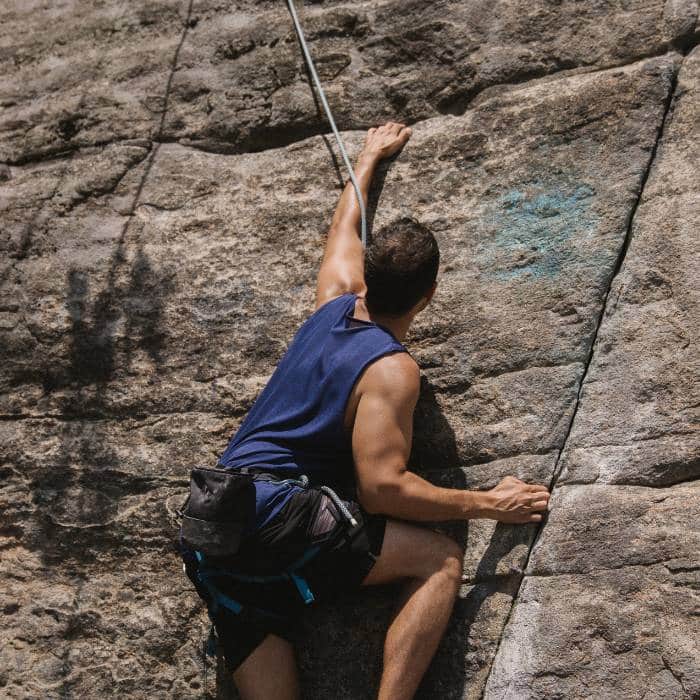Welcome to the thrilling world of rock climbing. It’s a sport that combines strength, grit, and the joy of reaching new heights. Climbing offers diverse adventures, ranging from adrenaline-fueled free solo ascents to strategically plotting trad routes. It is for enthusiasts of all levels.

Diving into climbing isn’t just about muscle and bravery; it’s also about mastering a unique language that binds the community. Terms like crimp, gaston, and smearing are more than jargon; they’re the keys to unlocking efficiency, safety, and fun on the rock.
So, lace up your rock climbing shoes, chalk up, and let’s decode the language of the vertical world together. Ready for a rock climbing? Let’s go!

List of Rock Climbing Terms
Here’s your guide to seamlessly mastering the climber’s language:
| Term | Definition |
| Aid Climbing | Climbing using gear for upward progress, not just protection. |
| Anchor | A setup of one or more pieces of gear to secure the climber or belayer. |
| Approach | The walk or hike to the base of a climb. |
| Arete | A narrow ridge of rock formed by two intersecting planes of rock. |
| Auto-block | A friction hitch used in climbing for self-belaying on a rope. |
| Auto-lock | A feature of some devices that automatically lock under load. |
| Belay | The rope management process to secure a climber during their ascent or descent. |
| Beta | Information about a climb’s moves and technique. |
| Bight | A bend or loop in the rope. |
| Bolt | Metal anchors drilled into the rock for protection. |
| Cam | A spring-loaded camming device used for protection in rock cracks. |
| Carabiner | A metal loop with a spring-loaded gate used to connect climbing equipment. |
| Chalk | Magnesium carbonate used to dry hands for better grip. |
| Chimney | A wide crack big enough to fit the climber’s body. |
| Choss | Loose or poor-quality rock. |
| Crack Climbing | A climbing technique for ascending cracks by wedging body parts into them. |
| Crash Pad | A portable pad used under bouldering routes to cushion falls. |
| Crimp | A small hold that requires the use of fingertips. |
| Deadpoint | A climbing move where the climber reaches for a hold at the apex of upward momentum. |
| Deck | To fall to the ground from a climb. |
| Dihedral | A corner where two rock faces meet at an angle, inward-facing. |
| Dyno | A dynamic move where the climber jumps to reach a hold. |
| Edge | A small, defined ledge or lip that can be used as a foot or handhold. |
| Equalized | A climbing anchor setup where the load is distributed evenly across multiple points. |
| Face Climbing | Climbing on vertical rock faces using holds such as edges and pockets. |
| Figure-eight Knot | A common type of knot used in climbing, often for tying into a harness. |
| Flake | A thin piece of rock detached or partially detached from the main rock face. |
| Flash | To successfully climb a route on the first attempt with prior knowledge of the climb. |
| Gaston | A style of climbing moves where a handhold is pushed outward rather than pulled inward. |
| Gear | General term for the equipment used in climbing. |
| Grade | A system used to rate the difficulty of climbs. |
| GriGri | A brand name for a popular belay device with an auto-locking feature. |
| Heel Hook | A technique where climbers use their heels to hook a hold or feature. |
| Jug | A large, easy-to-grip hold. |
| Knee Bar | A technique where climbers wedge their knees against a rock feature for support. |
| Layback | A technique where the climber leans back against a hold and presses their feet against the opposite wall. |
| Lead Climbing | Climbing where the climber ascends with the rope below them, clipping into protection as they go. |
| Mantle | A move where the climber uses their arms to press down and lift their body onto a ledge or feature. |
| Multi-pitch Climbing | A climb that is longer than the length of one rope, requiring multiple sections (pitches) to complete. |
| Nut | A small, wedge-shaped piece of metal placed into cracks for protection. |
| Off-width | A crack too wide for effective hand or finger jams but too narrow to chimney. |
| On-sight | To successfully climb a route on the first attempt without prior knowledge or seeing it climbed. |
| Overhang | A section of rock that leans out beyond vertical. |
| Pitch | A section of a climb, often defined by the length of a rope or a natural stopping place. |
| Protection (Pro) | Equipment placed or used to prevent a long fall. |
| Pumped | The feeling of lactic acid buildup in the forearms, causing weakness and loss of grip. |
| Quickdraw (Quickie) | A set of two carabiners connected by a short, semi-rigid material used to clip the climbing rope for protection. |
| Rappel (Abseil) | To descend a cliff or slope with the aid of a rope. |
| Redpoint | To successfully climb a route after having practiced it. |
| Route | The path up a rock face or mountain that a climber follows. |
| Runner | A length of webbing or cord used to extend the connection between the climbing rope and protection, reducing rope drag. |
| Send | To successfully climb a route without falling or resting on the gear. |
| Single Rope | A rope designed for climbing where only one rope is used, as opposed to double or twin rope techniques. |
| Slab | A type of climb on a rock face that is less steep than vertical, often requiring balance and friction. |
| Sling | A loop of webbing or cord, similar to a runner, used in anchoring and extending protection. |
| Smear | A climbing technique where the climber relies on the friction between the sole of their shoe and the rock, without any distinct holds. |
| Spot | To assist a boulderer by guiding their fall to prevent injury without physically supporting them during their climb. |
| Static move | A climbing move made with slow and controlled motion instead of dynamic moves. |
| Stemming | A technique where the climber uses opposition between two surfaces to maintain balance and support. |
| Stick clip | A tool used to pre-clip the first bolt on a sport route to minimize the risk of a ground fall. |
| Top rope | Climbing with the rope anchored at the top of the climb, reducing the distance of potential falls. |
| Traditional climbing (Trad climbing) | Climbing where climbers place all necessary protection as they ascend, and then remove it when descending, leaving no trace. |
| Traverse | Climbing horizontally across a rock face. |
| Undercling | A hold grasped from beneath, with the palm facing upwards, often requiring significant body tension. |
| Whipper | A long or dramatic fall taken by a lead climber. |
| Z-clip | A mistake made when lead climbing, where the climber clips the rope through a quickdraw to form a ‘Z’ shape and can lead to rope drag or safety issues. |
Takeaway
So, whether you’re a seasoned climber or a newbie, having a solid grasp of rock climbing terms can enhance your time on the wall. From crimps to smearing and slopers to dynos, knowing the language of climbing can help you talk with other climbers and improve your technique.
So next time you hit the crag, brush up on your rock climbing glossary and have fun sending those climbing routes!


